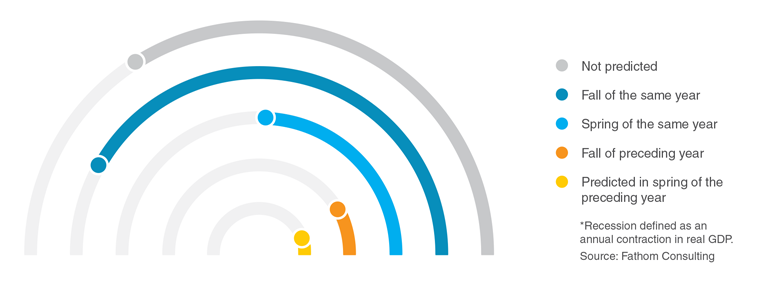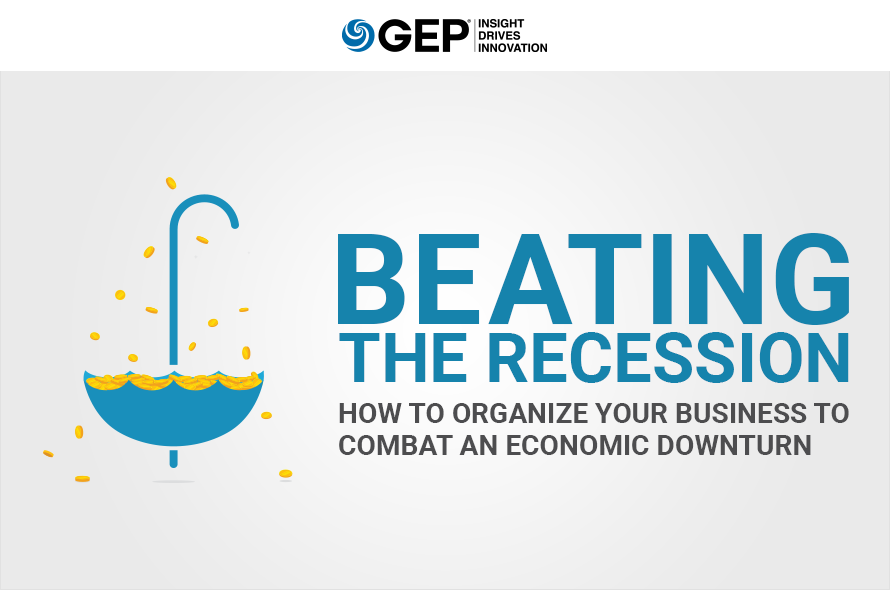Economic growth is cyclical. Which means another recession is quite likely, if not inevitable.
Are we heading into one? The jury’s still out.
In the meantime, what can enterprises do to build resilience against a downturn? What steps can you take now to sail through tough times?
A new GEP white paper — Beating the Recession: How to Organize Your Business to Combat an Economic Downturn — discusses the unpredictability of a recession, the current economic situation, and the need to prepare for adverse market conditions even when business is thriving. It also presents seven effective strategies for enterprises to build resilience against an economic downturn.
Why Read It:
- The need to stay prepared for a recession, before it happens
- State of the global economy and key indicators of a downturn
- Seven effective strategies to mitigate the impact of a recession
A must-read for all business leaders focused on creating sustainable growth for the enterprise.
INTRODUCTION
One of the most difficult topics for business leaders to address is the possibility of an impending economic downturn. Nobody wants to be seen as a pessimist or as a rocker of boats, especially when the company is thriving. Any attempt to begin discussions on how to “recession-proof” the organization — especially in a prosperous climate in which corporations have experienced record-high profits — will be met with skepticism and reluctance. However, not drawing up a plan to address a reversal of market conditions — which most experts would acknowledge as inevitable — is foolish and naive. As a wise person once said: “Failing to plan is planning to fail.”1

It is, therefore, of paramount importance to plan for a recession. But predicting when one will occur is a fool’s errand. The only foolproof strategy to protect a business against recession is to begin planning today, when the outlook is bullish. History has shown that it is more likely that an economist will fail to predict a recession than forecast one that never occurs. The most recent example of an unforeseen slowdown is the Great Recession of the late 2000s and early 2010s.
In fact, of the 469 global downturns that have occurred since 1988, the International Monetary Fund (IMF) was able to predict only four by the spring of the preceding year. According to Andrew Bridgen, chief economist at leading research consultancy firm Fathom Consulting, “Since 1988, the Fund has never forecast a developed economy’s recession with a lead of anything more than a few months (Figure 1, Table 1).” Another study found that “of 153 recessions in 63 countries from 1992 to 2014, only five were predicted by a consensus of private-sector economists in April of the preceding year.”
Figure 1
FEW HITS, LOTS OF MISSES
Recessions in 194 countries since 1988: by when they were predicted in the IMF’s World Economic Outlook (WEO)*

Table 1
IMF RECESSION FORECASTS SINCE 1988(1)
| Across 194 countries | Of these, advanced economies | |
|---|---|---|
| Total number of recessions |
469 |
79 |
| Of which: predicted in Fall WEO of same year |
182 |
52 |
| Predicted in Spring WEO of same year |
111 |
32 |
| Predicted in Fall WEO of preceding year |
13 |
4 |
| Predicted in Spring WEO of preceding year |
4 |
0 |
(1) Here we define a recession as an annual contraction in real GDP
Source: Fathom Consulting
With historical evidence demonstrating the inadequacy of predictions regarding the next recession,2 leaders must proactively prepare their businesses for downturns.
A comprehensive business strategy to address a future economic recession is not simply a set of ad hoc actions that can be performed as soon as the market begins to show signs of a turning tide. A thorough plan consists of anticipatory analysis and long-term, pre-planned strategic responses that, when properly applied and implemented, will help businesses weather poor economic conditions.
This white paper recommends seven strategic levers that C-level executives can use to make their organizations more resilient to the impacts of future economic changes.

THE CURRENT SITUATION
The United States economy is strong,3 and corporations have been posting their best financial results in years.4 The good times will not last forever, however. The economy is already showing some signs of stress, and the U.S. Commerce Department has revised the GDP growth rate downwards, while both the Federal Reserve and the U.S.-based National Association for Business Economics have lowered their forecasted growth rates for 2019.5 The Wall Street Journal has reported that investors are predicting the end of the long bull market and bracing for hits to corporate profits.6
Slowing global economies and the diminishing positive impact of 2017’s domestic tax cut in the U.S. have investors worried about the first quarterly profit decline in two years.7, 8 On March 22, 2019, the U.S. bond market flashed a warning sign when the yield on 10-year treasury notes dipped below the yield on three-month treasury bills.
This “yield curve inversion” has generally been followed by a recession, though the length of time from inversion to recession varies (Table 2).
Table 2
INVERTED YIELD CURVE (10-YR MINUS 1-YR) AND RECESSIONS (1956-PRESENT)
| Recession Start | Recession End | Inverted Curve Before Recession? | First Yield Curve Inversion | Lead (Months) |
|---|---|---|---|---|
| Aug ’57 | Apr ’58 | Yes | Dec ’56 | 8 |
| Apr ’60 | Feb ’61 | Yes | Sep ’59 | 7 |
| Dec ’69 | Nov ’70 | Yes | Dec ’67 | 24 |
| Nov ’73 | Mar ’75 | Yes | Mar ’73 | 8 |
| Jan ’80 | Jul ’80 | Yes | Sep ’78 | 16 |
| Jul ’81 | Nov ’82 | Yes | Sep ’80 | 10 |
| Jul ’90 | Mar ’91 | Yes | Feb ’89 | 17 |
| Mar ’01 | Nov ’01 | Yes | Apr ’00 | 11 |
| Dec ’07 | Jun ’09 | Yes | Jan ’06 | 23 |
| Average Lead Time | 14 | |||
Source: Charlie Bilello/Pension Partners
Foreign economies have not fared any better. China continues to experience cooling growth against the backdrop of an escalating trade war; Britain faces the looming economic consequences of Brexit; Italy just exited a recession after two straight quarters of shrinking GDP output in Q3 and Q4 2018; and Germany and France are at risk of stagnating economies.
Here are seven strategies that business leaders can implement to mitigate the impact of a future recession on their enterprises:
LEVER 1
Negotiate Smart Contracts
It is critical for businesses to manage supplier relationships in a way that allows them to remain agile and adapt quickly to changing economic conditions. One way a leader can enable this is by prioritizing the negotiation of smart contracts.
When a recession occurs, the demand for goods and services will plateau as cash-strapped customers stop spending money and even try to cancel already-placed orders. This can present a significant supply chain problem for companies, in particular for those that need long lead times and large on-hand inventories. When a company’s revenue stream diminishes at a rate faster than it is able to cut its operating expenses, there’s a profit squeeze. Supply chain leaders can avoid this pitfall by prioritizing flexible contracts, which, for example, can define legal provisions for time fences for the transfer of ownership as well as provide favorable cancellation penalties. Forward thinking and foresight will help businesses mitigate devastating profit and loss risks that will likely affect those that don’t have strategic “recession- proofing” plans in place.
LEVER 2
Identify Alternative Suppliers
Leaders can take preemptive steps and address vulnerabilities in their supply chains by identifying alternative suppliers and vendors. Any disruption to the supply chain is expensive, and if an organization is significantly dependent upon a single entity that is no longer able to deliver the promised goods or services, this one supplier can be a potential risk to the business itself. Nobody is immune to a poor economy, and an economic downturn hits the enterprise and its supply base alike. To “recession-proof” the business, it is crucial for companies to build relationships with alternative suppliers while times are good. As Forrester’s VP and principal analyst Ray Wang writes: “[Companies] must always mitigate the risk of vendor lock-in and identify alternatives to the incumbent.”9
LEVER 3
Create a Variable Cost Structure
It is important for businesses to stay lean and be equipped to adjust and respond quickly to changes in the marketplace without major operational disruptions. One way to do this is by building a workforce that has a variable cost structure. Hiring contractors and freelancers gives organizations the flexibility to scale down during a recession, when demand falters.
The advantage to this staffing approach is that the business can avoid internal layoffs, which are bad for workforce morale. Jennifer Earley, owner and marketing strategist at Amplified Marketing Services, writes: “Layoffs leave a wide wake of damage, impacting the livelihood of the people let go, disrupting the business, and even tarnishing culture and brand.”10
Business leaders can also go one step further and consider outsourcing manufacturing operations. Large, fixed costs — such as property, plants, and equipment — do not diminish when demand stalls. Outsourcing can make it easier for companies to scale their supply operations accurately and in proportion to consumer demand.
LEVER 4
Maintain Tight Inventory Control
Excess inventories are the bane of any business, and more so when demand is low. Supply chain professionals can circumvent this issue by implementing smart inventory management practices, with the primary goal being to minimize total carrying costs.
Buying inventory ties up working capital, while storing excess inventory increases overhead costs. Unmoving inventory and slow-selling products block funds from being invested in other necessary aspects of the business. During a recession, the effect this has on the business becomes more pronounced as obtaining capital and credit from lenders becomes more difficult. Supply chain managers can avoid this pitfall by reducing the amount of inventory being held.
LEVER 5
Build a Flexible Workforce
Maintaining a lean, agile, multi-skilled workforce is essential for “recession-proofing” the business. It is a best practice to cross-train employees in several key roles so that they can perform duties within different areas of the business. This flexibility will enable the company to do more with less and respond quickly to changes in the marketplace.
LEVER 6
Ensure Cash Flow
Business leaders must safeguard their organization by taking decisive actions that guarantee constant cash inflow. One way to achieve this is through strict enforcement of payment terms. Long-term, trustworthy customers are also susceptible to the consequences of a sluggish economy, so it’s important to impose payment terms politely but rigorously, even if it means disappointing loyal customers and saying no.
Another way to safeguard revenue is to make sure that the business is not reliant upon a single — or even two or three — goods, services or clients. A wide range of offerings and customers will give the company the best chance of successfully enduring the challenges and hardships of a recession.
LEVER 7
Focus on Customer Centricity
To safeguard your business, you must safeguard your clients’ interests. Ensuring that there is a constant steam of revenue is important, but it is even more crucial to prioritize your clients’ needs. This, for instance, could mean rejecting certain business ventures and opportunities.
For example, a company that constantly overpromises and underperforms because of staff shortages will earn a poor reputation, which in turn will impact its ability to attract more customers in the future.
Quality and reliability are important at all times, but especially so when there’s an economic slowdown and profits are getting squeezed, because businesses can’t afford to take any risks. Satisfied customers will translate to steady, repeat customers. Satisfied clients are also more likely to share their good experience, spread the word about your products or services, and recommend your business.
Maintaining your business reputation will also gain your organization trust and confidence, which can lead to the generation of more business in the future.
IN CONCLUSION
Prepping for the Change
It may not be easy to initiate discussions with colleagues and board members about the impact of an economic slowdown on the business when your numbers are up and the overall climate is looking good. But neglecting to do something that makes you momentarily uncomfortable can mean the difference between success and failure for your organization.It’s much easier to think clearly, weigh options and make changes when recession is still a possibility, not the reality. Start the conversation now, and “recession-proof” your business with the strategies in this white paper.
References
- Often attributed — without substantive evidence — to Benjamin Franklin
- Kennedy, Simon, and Peter Coy. “Why Are Economists So Bad at Forecasting Recessions?” Bloomberg Businessweek, 28 March 2019. Retrieved from bloomberg.com/news/articles/2019-03-28/economists-are- actually-terrible-at-forecasting-recessions
- Hughes, Robert. “Corporate Profits Hit a New Record as GDP Growth Is Revised Higher,” American Institute of Economic Research, 29 August 2018. Retrieved from aier.org/article/corporate-profits-hit-new-record-gdp- growth-revised-higher
- Bartash, Jeffry. “Economy Grew 3.5% in Third Quarter, Pushing Corporate Profits to 6-Year High, GDP Shows,” MarketWatch, 28 November 2018. Retrieved from marketwatch.com/story/economy-grew-35-in-third-quarter- pushes-corporate-profits-to-6-year-high-gdp-shows-2018-11-28
- Horsley, Scott. “Say It One More Time: The Economy Is Slowing,” NPR, 28 March 2019. Retrieved from npr. org/2019/03/28/707566015/say-it-one-more-time-the-economy-is-slowing
- Wallace, Joe, and Akane Otani. “Investors Brace for Hit to Profits as Costs Rise,” Wall Street Journal, 3 April 2019. Retrieved from wsj.com/articles/investors-brace-for-hit-to-profits-as-costs-rise-11554283800
- Butters, John. “Earnings Insight,” FactSet, 29 March 2019. Retrieved from factset.com/hubfs/Resources%20 Section/Research%20Desk/Earnings%20Insight/EarningsInsight_032919.pdf
- Li, Yun. “Profits in the First Quarter Are Now Expected to Decline as Company Outlooks Fall Short,” CNBC, 5 February 2019. Retrieved from cnbc.com/2019/02/05/profits-in-the-first-quarter-are-now-expected-to- decline-as-company-outlooks-fall-short.html
- Wailgum, Thomas. “Five Tips to Create a Recession-Proof ERP Vendor Strategy,” CIO, 14 January 2009. Retrieved from cio.com/article/2431311/five-tips-to-create-a-recession-proof-erp-vendor-strategy.html
- Post, Jennifer. “How to Recession-Proof Your Business,” Business News Daily, 1 February 2019. Retrieved from businessnewsdaily.com/11263-recession-proof-business-tips.html
Additional Sources
- Barlow, Buckley. “Recession Business Strategy: What to Do Before, During, and After a Recession,” Rocket Source, 30 May 2018. Retrieved from rocketsource.co/blog/recession-business-strategy/
- Lifshitz, Eyal. “Times Are Good, So Start Working Now to Make Your Small Business Recession-Proof,” Entrepreneur, 5 September 2018. Retrieved from entrepreneur.com/article/318818
- Richason, Owen. “How to Manage a Business in a Recession,” Houston Chronicle, 18 July 2010. Retrieved from smallbusiness.chron.com/manage-business-recession-2468.html
- Ward, Susan. “7 Ways to Make Your Business Thrive in Tough Economic Times,” The Balance Small Business, 27 January 2019. Retrieved from thebalancesmb.com/business-thrive-tough- economy-2948298
- Altman, Ian. “When Turning Down a Customer Is the Best Thing to Do,” Forbes, 7 February 2017. Retrieved from https://www.forbes.com/sites/ianaltman/2017/02/07/when-turning-down-a-customer-is-the-best-thing-to-do/?sh=790c1ff74440

